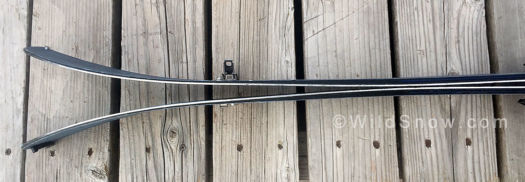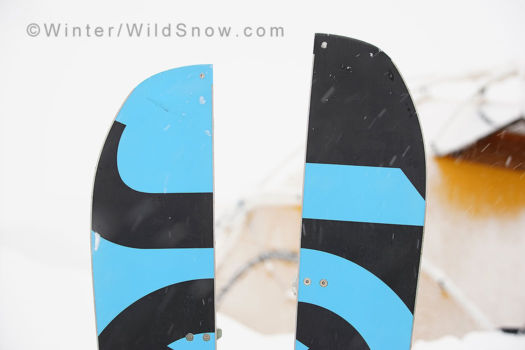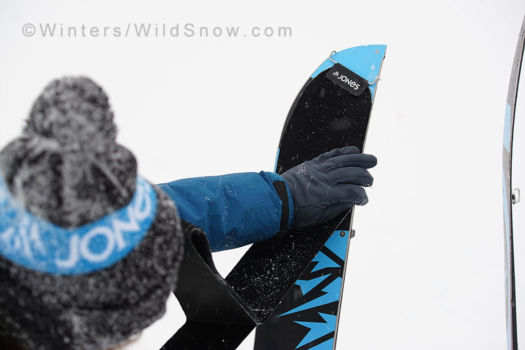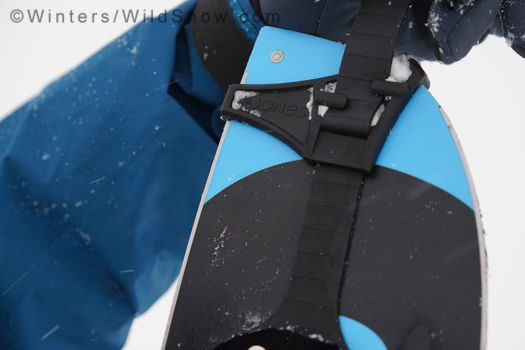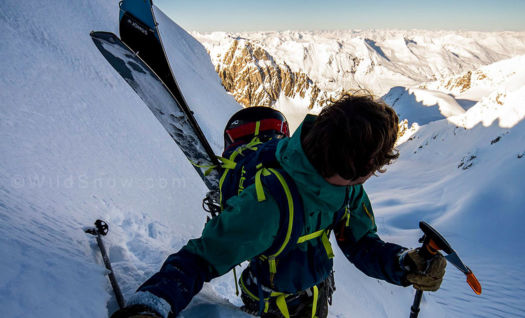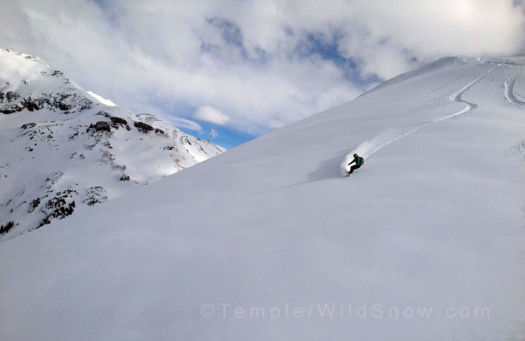
The Jones Solution and a classic tour in the San Juans – these are the conditions we would love to be in all the time.
Splitboards are a dynamic tool for the backcountry snowboarder; the potential they help us access is truly limitless. I have ridden a number of different splits, from fully rockered twin tips to fully cambered swallow tail shapes, in a wide variety of conditions. Time to put down my thoughts on what’s been working.
Owning a quiver of splitboards for all of the different conditions you will encounter out there can be unreasonable, so what should you look for to simplify life? It is imperative to find a shape and size that will “ski tour” uphill exceptionally well, as the reality is we spend 95% of our time going up. Of course, we all live for the gravity assisted descent, so that same tool must perform equally as well on the down.
I’ve been utilizing a Jones Solution splitboard for almost four years, and the new 15/16 model for about a year and a half. The shape and design of the Solution makes it a recommendable tool for the board quiver of one.
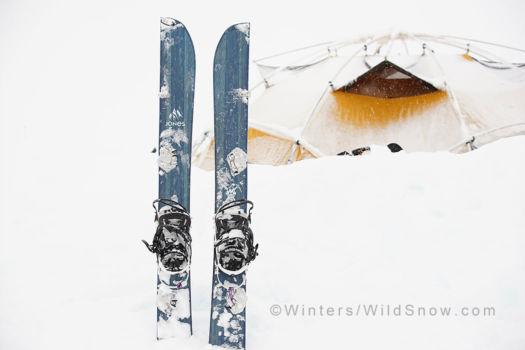
The Solution on a wild month-long trip in Glacier Bay National Park.
The 2015/2016 Jones Solution has a number of updates to the construction that have drastically improved its quality, despite a couple of potential drawbacks to this board.
The profile of the board is ideal for the uphill and includes critical features that allow it to perform well on both sides of the spectrum. The importance of a cambered shape in the profile for skinning far outweighs any counter arguments I’ve heard about riding performance.
The Solution is a directional board with camber between the feet, coupled with slight rocker towards the tip and tail. I have found this profile to perform well in the variety of conditions you will encounter in the backcountry. The rockered nose floats in powder and charges through the chunder and mank that inevitably exists no matter when you go out.
Similarly, the camber between the feet gives the necessary edge control for firm conditions. While touring the rockered nose creates float when breaking trail, but this profile really shines when it is combined with the camber in the center of the board. The camber between the feet and under the touring bracket provides support and stability in both deep snow conditions and firm hardpack.
My biggest complaint about a fully rockered profile is largely in the touring performance, I equate it to walking uphill with two bananas under your feet. It will provide float in the deepest of conditions, but minimal support.
Similarly, when you are clinging for dear life on an icy uptrack, the rocker in your skis keeps just the right amount of surface area off the snow for a potential struggle fest. Yes, this is a moderately exaggerated rant about fully rockered shapes — but it’s real.
Fortunately, Jones has combined the useful parts of the rockered technology with the benefits and old technology of camber to make a functional uphilling tool.
The same profile that makes the Solution perform well on the uphill, is the same technology that makes it a good choice for the all around descent. I’ve ridden some of my deepest days and had excellent floatation, and also some of my most hateful surface conditions and had good control and ability to charge through crud.
The updated materials in the 15/16 construction have to do with a new topsheet and edge design. The new topsheet is made of castor beans and is claimed to be lighter, stronger, and more durable (insert other buzzword here). I’ll agree to the durability part, as it’s hard for me to weigh just the top sheet of both models.
The darker colored topsheet (although not black, thank goodness) does sometimes collect snow and ice up, but I am a sucker for that teal blue color so I’ll deal with it for the fashion statement.
The previous models of the solution had a full wrap around edge on the tip and tail with a metal plate in the base that often became damaged by hitting rocks and would bend or break out. The 15/16 model does not have that, and has held up exceptionally well to the all too familiar San Juan Shark Attack. A quality improvement!
A potential drawback to the Jones Solution is the thickness of the base. I tagged a rock a few weeks ago in the San Juan backcountry and put a decent sized core shot in my base from what I perceived to be a relatively minimal impact. After inspecting the thickness of the base, I began to question the durability. I know there is a balance to strike in durability and lightweight performance, but it did raise some questions for me. Fortunately the ding was easy enough to repair, and I have not had any significant problems since then despite hitting plenty of rocks — San Juan Shark Week (season) 2016.
Another new product from Jones is the addition of climbing skins. I have been using the Premium Skins, which is essentially a rebranded Pomoca skin that is 70% mohair and 30% synthetic nylon fibers.
Jones Premium Skins are superb, truly. The glide to grip ratio is effective, and the glue has held up well so far. I have definitely put them through the wringer with the occasional dirt patch skinning, and over sharp rocks, and they are holding up so far. Time will tell, and I’ll follow-up with more info if I notice significant changes.
The 15/16 Solution is designed with a notch in the back of each ski to accommodate a “quick-tension tail-clip”. I have been using the skins with the universal tail clip, so I cannot speak to the effectiveness of the quick-tension clip, but it seems like a good innovation nonetheless.
Overall, the 15/16 Jones Solution is a highly recommendable board for the one split quiver. It has the profile to be effective on the ski uphill, and versatile for the down. The board without hardware weighs in at 3220 grams, and the skins weigh in at 490 grams for the pair.
(I bought my first Jones splitboard, current one is a loaner from Jones for testing and review.)
Shop for Jones splitboards here.

Jonathan Cooper (“Coop”) grew up in the Pacific Northwest and has been playing in the mountains since he was a teen. This was about the same time he made the fateful decision to strap a snowboard to his feet, which has led to a lifelong pursuit of powdery turns. Professionally speaking, he has been working as a ski guide, avalanche educator, and in emergency medicine for over a decade. During the winter months he can be found chasing snow, and passing on his passion for education and the backcountry through teaching avalanche courses for numerous providers in southwest Colorado, and the Pacific Northwest. Similarly, his passion for wilderness medicine has led him to teach for Desert Mountain Medicine all over the West. If you’re interested, you can find a course through Mountain Trip and Mountain West Rescue. In the end, all of this experience has merely been training for his contributions to the almighty WildSnow.com.


